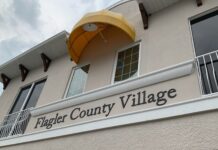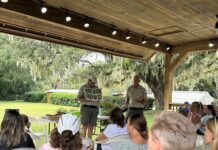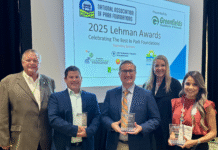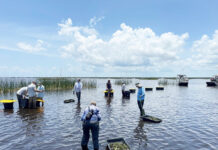May 25, 2023 – Flagler County officials met with Florida Department of Economic Opportunity Acting Secretary Meredith Ivey and the department’s Director of the Office of Long-Term Resiliency Justin Domer to discuss the needs and gaps illuminated by Hurricane Ian and Hurricane Nicole in 2022.
“It was great to meet the folks from the Office of Long-Term Resiliency,” said Deputy County Administrator Jorge Salinas, who took part in the discussions along with Emergency Management Director Jonathan Lord, Housing Program Manager Devrie Paradowski, Budget Analyst Michael Catalano, Health and Human Services Director Joseph Hegedus, Tourism Development Director Amy Lukasik, and Economic Development Manager Dolores Key. “This was an informative meeting where we discussed available programs and project ideas for Community Development Block Grants (CDBG) in the areas of Disaster Recovery (DR) and Mitigation (MIT).”
The Office of Long-Term Resiliency was created in 2019 and was federally allocated funding to support communities following disasters. Its goal is to address long-term recovery needs for housing, infrastructure, economic development, workforce training, and mitigation activities. It is also responsible for administering all HUD (Housing and Urban Development) long-term recovery funding that is awarded to the state.
“We discussed Community Planning Technical Assistance for grant applications, which would be a great help to us as we have extremely limited resources to develop grant applications,” Lord said. “It’s been on my list for a long time to harden the Hidden Trails Community Center on the west side so that we can make it a shelter that can withstand hurricanes and tornadoes.”
Flood waters that lingered for weeks and greatly impacted some areas, like the county-owned Bull Creek Campground, were also discussed. Lord also discussed a recommendation he made in January before the Florida House Select Committee on hurricane resiliency and recovery.
“I spoke about building on the FEMA mitigation program that allows homeowners in flood prone areas to either elevate their homes or potentially sell them to local governmental agencies to be returned to open space that can possibly absorb floodwaters to protect neighboring structures,” Lord said. “It would be helpful if there was a shift in the grant and project management from local government to the state, using federal funds, to prevent burdening local taxpayers with managerial expenses for the grants.”
The dunes and State Road A1A were also among the discussion topics.
“These (dunes and State Road A1A) are part of the critical infrastructure that protects homes and businesses,” Lukasik said. “Besides being critical infrastructure, they are key economic and tourism drivers.”
Flagler officials also learned from the Department of Economic Opportunity its findings from previous storm-related response and recovery efforts.
“We made certain we let Secretary Ivey and Director Domer know that we are interested locally, should funding become available, for any opportunities related to mitigation and related areas of recovery,” Hegedus said. “Sometimes rolling out a new program can be difficult – timing can be tricky – but we are a willing partner and will do everything within our ability to ensure that everything operates smoothly.”
Hurricane Ian, which brought with it an average of more than 15 inches of rain and historic flooding to the western reaches of the county and coastal erosion on the barrier island, caused an estimated $11 million in residential and business damages and an additional $6 million in local governmental expenditures. These figures do not include the damages to Flagler’s 18 miles of beaches and dune system.
Nicole, which battered areas with Ian-weakened infrastructure fewer than six weeks afterward, is estimated to have caused about $29 million in residential and business damages and an additional $6 million in local governmental expenditures. Again, these estimates do not include damages to the beaches and dune system.
The Rebuild Florida Program within the Office of Long-Term Resiliency awarded more than $685 million to communities impacted by hurricanes and other natural disasters during the 2021-22 fiscal year. These funds were used to address long-term recovery needs for housing, infrastructure, and economic development including more than $109 million for infrastructure repair and $273 million to mitigate future disasters.
Follow Flagler County Government on Facebook: www.facebook.com/FlaglerCountyGovernment














































